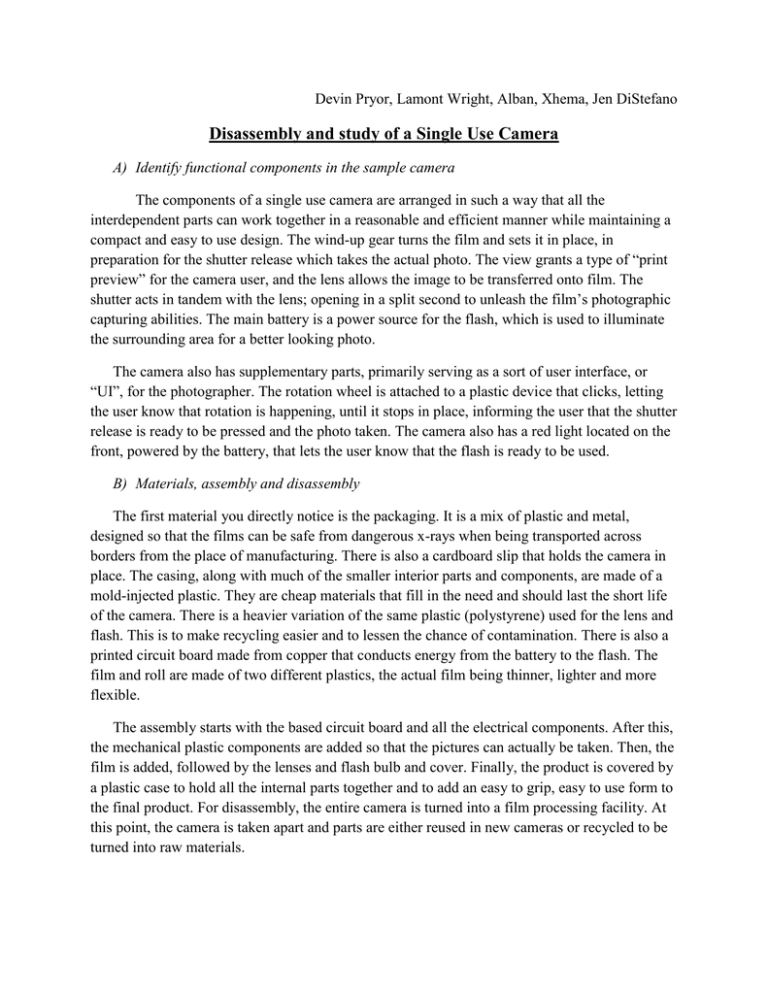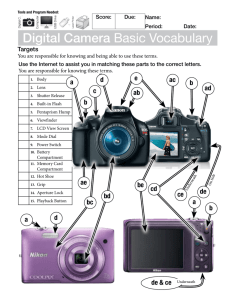Disassembly and study of a Single Use Camera
advertisement

Devin Pryor, Lamont Wright, Alban, Xhema, Jen DiStefano Disassembly and study of a Single Use Camera A) Identify functional components in the sample camera The components of a single use camera are arranged in such a way that all the interdependent parts can work together in a reasonable and efficient manner while maintaining a compact and easy to use design. The wind-up gear turns the film and sets it in place, in preparation for the shutter release which takes the actual photo. The view grants a type of “print preview” for the camera user, and the lens allows the image to be transferred onto film. The shutter acts in tandem with the lens; opening in a split second to unleash the film’s photographic capturing abilities. The main battery is a power source for the flash, which is used to illuminate the surrounding area for a better looking photo. The camera also has supplementary parts, primarily serving as a sort of user interface, or “UI”, for the photographer. The rotation wheel is attached to a plastic device that clicks, letting the user know that rotation is happening, until it stops in place, informing the user that the shutter release is ready to be pressed and the photo taken. The camera also has a red light located on the front, powered by the battery, that lets the user know that the flash is ready to be used. B) Materials, assembly and disassembly The first material you directly notice is the packaging. It is a mix of plastic and metal, designed so that the films can be safe from dangerous x-rays when being transported across borders from the place of manufacturing. There is also a cardboard slip that holds the camera in place. The casing, along with much of the smaller interior parts and components, are made of a mold-injected plastic. They are cheap materials that fill in the need and should last the short life of the camera. There is a heavier variation of the same plastic (polystyrene) used for the lens and flash. This is to make recycling easier and to lessen the chance of contamination. There is also a printed circuit board made from copper that conducts energy from the battery to the flash. The film and roll are made of two different plastics, the actual film being thinner, lighter and more flexible. The assembly starts with the based circuit board and all the electrical components. After this, the mechanical plastic components are added so that the pictures can actually be taken. Then, the film is added, followed by the lenses and flash bulb and cover. Finally, the product is covered by a plastic case to hold all the internal parts together and to add an easy to grip, easy to use form to the final product. For disassembly, the entire camera is turned into a film processing facility. At this point, the camera is taken apart and parts are either reused in new cameras or recycled to be turned into raw materials. C) Labeled Parts D) Reuse and Recycle Certain parts of cameras can be reused while others can only be recycled, then potentially remade for future cameras. Reusable parts would most likely include the circuit board, casing, lens, and whatever plastic parts that can still be used. Obviously, these are all very dependent on which parts are damaged and which are still functioning properly and intact. Parts that would never be reused and would have to be recycled are the packaging, battery, and film, as well as any internal parts that have been damaged. E) Flow Chart of Systems Redesign Idea: After reviewing the wasteful aspects of a disposable camera, we determined that the energy source – currently a battery – could be redesigned. An idea that we had to reduce the waste of the energy source was to make the camera solar powered, similar to a basic solar powered calculator. There would be a small solar panel on the top of the camera that would allow it to absorb energy from light, thereby eliminating the need for a battery to provide energy to the flash. Since the flash does require a decent amount of energy, the user would have to be sure to leave the solar panel exposed to light when not in use so it could build up the energy necessary for its next use. This redesign would prevent the waste of a AA battery in every disposable camera.






